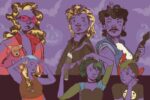“Thankfully, I have never gone to a Halloween party where I’ve bumped up against, well, myself.” This is how Monica Lewinsky started off a frank column for Vanity Fair in 2015 about the experience of watching herself becoming a Halloween costume.
After Lewinsky’s affair with then-President Bill Clinton came to light in the late 1990s, America couldn’t get enough of the story—so much that when it comes to October 31, exaggerated, garish “Monica Lewinskys” seemed to be everywhere, complete with the infamous blue dress and a cheeky beret.
Though that was almost 20 years ago, the sentiment behind the Monica costume is alive and well every Halloween season. The formula is simple: newsmakers = genius source of costume ideas. Every year, new costumes arise based on the splashiest news stories of the year, inevitably leading to outfits that exaggerate or attempt to impersonate real people.
In 2015, the most popular were Caitlyn Jenner and Rachel Dolezeal. This year? Almost without question, Hillary Clinton and Donald Trump will lead the pack. While these costumes may seem to be clever Halloween fun, the damage they can inflict on a person’s image can be brutal.
Watching an exaggerated version of yourself gaining popularity among thousands is rarely a pleasant experience, but it’s especially shell-shocking if you’re relatively new to fame. Lewinsky referred to “the darker side of Halloween” in her column, explaining that costumes can become hurtful “when someone begins the year as a private person and ends it in the aisle of a costume store.”
Lewinsky’s experience was particularly traumatic because she had lost control over her own narrative. She started the year of 1998 as a private person; by the end of that year, her whole existence had turned into the butt of a dirty cultural joke. She explained in a 2015 TED Talk that when this complete loss of her personal dignity occured on a global scale, “life was almost unbearable.” Turning Lewinsky, a real, living person, into a Halloween costume reduces her to a caricature of herself, and only serves to reinforce a narrow, mean-spirited perception of her character.
That process of socially stripping someone of their dignity actually has a name: dehumanization. In her 2017 book “Braving the Wilderness,” author and researcher Brene Brown writes about the dangers of dehumanization, or depriving someone of their right to be treated with the same dignity and respect as everyone else. Large-scale dehumanization can lead to racism and discrimination, but it can also happen on a very small scale, to individuals, when our culture deems someone as “worthy” of moral exclusion.
Small-scale dehumanization is exactly what happens when a real person is turned into a costume. When we dress up as someone else, we are ignoring that person’s well-rounded humanity and instead treating them like a vague shadow that is only defined by the news stories surrounding them.
Though one costume may seem insignificant, in the grand scheme of things, as dehumanization is born in the words and actions we use when we talk about another person, small, individual actions can add up to a whole lot of cultural hate.
Brown also talks about the importance of resisting dehumanizing language in all contexts, especially when it concerns politicians we disagree with. This will be especially important to keep in mind during Halloween 2017 when degrading versions of both Donald Trump and Hillary Clinton are sure to be partying it up left and right. It’s no secret that tensions were extremely high during the 2016 presidential election, and that dehumanizing language was used in the rhetoric on both sides of the aisle.
To move away from this toxic culture, Brown argues that no matter how difficult it may be sometimes, we must reject dehumanization tactics across the board; this means feeling equally frustrated and offended when Donald Trump is referred to as a pig as when Hillary Clinton is referred to as a bitch regardless of our political ideals or beliefs, so that we can move our national conversation to a less destructive space.
Finally, our greatest tool when combating the negative effects of turning real people into costumes is our own empathy. If we reduced everyone’s public persona to their worst possible self, or the worst mistake they’d ever made, we would all be living in constant shame and fear. Because such figures seem so remote from our own lives, we can easily fall into the trap of forgetting that the people featured on the nightly news are also just, well, people with parents, jobs and whole lives that don’t necessarily center around whatever tabloid headlines features about them.
Of course, I think this argument has its limits: there’s a distinct difference between contributing to the national shaming of Monica Lewinsky and dressing up as Taylor Swift (in a respectful, non-degrading way) because she’s your favorite singer. The heart of the matter is that thoughtless Halloween costumes are a smaller example of the larger national problem of separating empathy and moral concern from the people we see in Hollywood, in politics, and in everyday stories that go viral on social media.
Lewinsky put it best when she said, “Regardless of where we consider someone’s behavior, we might want to take a long, hard look at whether it makes sense for society to condone mocking such people—especially those who had never intended to become part of a global conversation in the first place.” This Halloween, take a moment to think about the cultural message your costume is sending and the implications it could have on someone else before you dress up and hit the town.

















